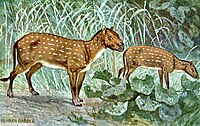User:Abyssal/Portal:Paleogene
IntroductionThe Paleogene Period (IPA: /ˈpeɪli.ədʒiːn, -li.oʊ-, ˈpæli-/ PAY-lee-ə-jeen, -lee-oh-, PAL-ee-; also spelled Palaeogene or Palæogene) is a geologic period and system that spans 43 million years from the end of the Cretaceous Period 66 million years ago (Mya) to the beginning of the Neogene Period 23.03 Mya. It is the first part of the Cenozoic Era of the present Phanerozoic Eon. The earlier term Tertiary Period was used to define the time now covered by the Paleogene Period and subsequent Neogene Period; despite no longer being recognized as a formal stratigraphic term, "Tertiary" still sometimes remains in informal use. Paleogene is often abbreviated "Pg", although the United States Geological Survey uses the abbreviation "Pe" for the Paleogene on the Survey's geologic maps. During the Paleogene period, mammals continued to diversify from relatively small, simple forms into a large group of diverse animals in the wake of the Cretaceous–Paleogene extinction event that ended the preceding Cretaceous Period. (Full article...) Selected article on the Paleogene world and its legacies The shell of a bivalve is composed of calcium carbonate, and consists of two, usually similar, parts called valves. These are joined together along one edge by a flexible ligament that, in conjunction with interlocking "teeth" on each of the valves, forms the hinge. The shell is typically bilaterally symmetrical, with the hinge lying in the sagittal plane. Adult shell sizes vary from fractions of a millimetre to over a metre in length, but the majority of species do not exceed 10 cm (4 in). Bivalves appear in the fossil record first in the early Cambrian more than 500 million years ago. The total number of living species is approximately 9,200. These species are placed within 1,260 genera and 106 families. Marine bivalves (including brackish water and estuarine species) represent about 8,000 species, combined in four subclasses and 99 families with 1,100 genera. The largestrecent marine family is the Veneridae, with more than 680 species. (see more...) Did you know?
Need help?Do you have a question about Abyssal/Portal:Paleogene that you can't find the answer to? Consider asking it at the Wikipedia reference desk. Selected image
Selected article on the Paleogene in human science, culture and economics
Oil shale, also known as kerogen shale, is an organic-rich fine-grained sedimentary rock containing kerogen (a solid mixture of organic chemical compounds) from which liquid hydrocarbons called shale oil can be produced. Shale oil is a substitute for conventional crude oil; however, extracting shale oil from oil shale is more costly than the production of conventional crude oil both financially and in terms of its environmental impact. Deposits of oil shale occur around the world. Estimates of global deposits range from 2.8 to 3.3 trillion barrels (450×109 to 520×109 m3) of recoverable oil.
Heating oil shale to a sufficiently high temperature causes the chemical process of pyrolysis to yield a vapor. Upon cooling the vapor, the liquid shale oil—an unconventional oil—is separated from combustible oil-shale gas (the term shale gas can also refer to gas occurring naturally in shales). Oil shale can also be burned directly in furnaces as a low-grade fuel for power generation and district heating or used as a raw material in chemical and construction-materials processing. Oil-shale mining and processing raise a number of environmental concerns, such as land use, waste disposal, water use, waste-water management, greenhouse-gas emissions and air pollution. Estonia and China have well-established oil shale industries, and Brazil, Germany, and Russia also utilize oil shale. (see more...) TopicsGeochronology - Paleogene (Paleocene - Eocene - Oligocene) Paleogene landmasses - Major Paleogene events - Paleogene biota appearances - Fossil sites - Stratigraphic units - History - History of paleontology - Timeline of paleontology Researchers - Culture - Treatise on Invertebrate Paleontology - Vertebrate Paleontology SubcategoriesQuality ContentThings you can doRelated contentAssociated WikimediaThe following Wikimedia Foundation sister projects provide more on this subject:
|




















